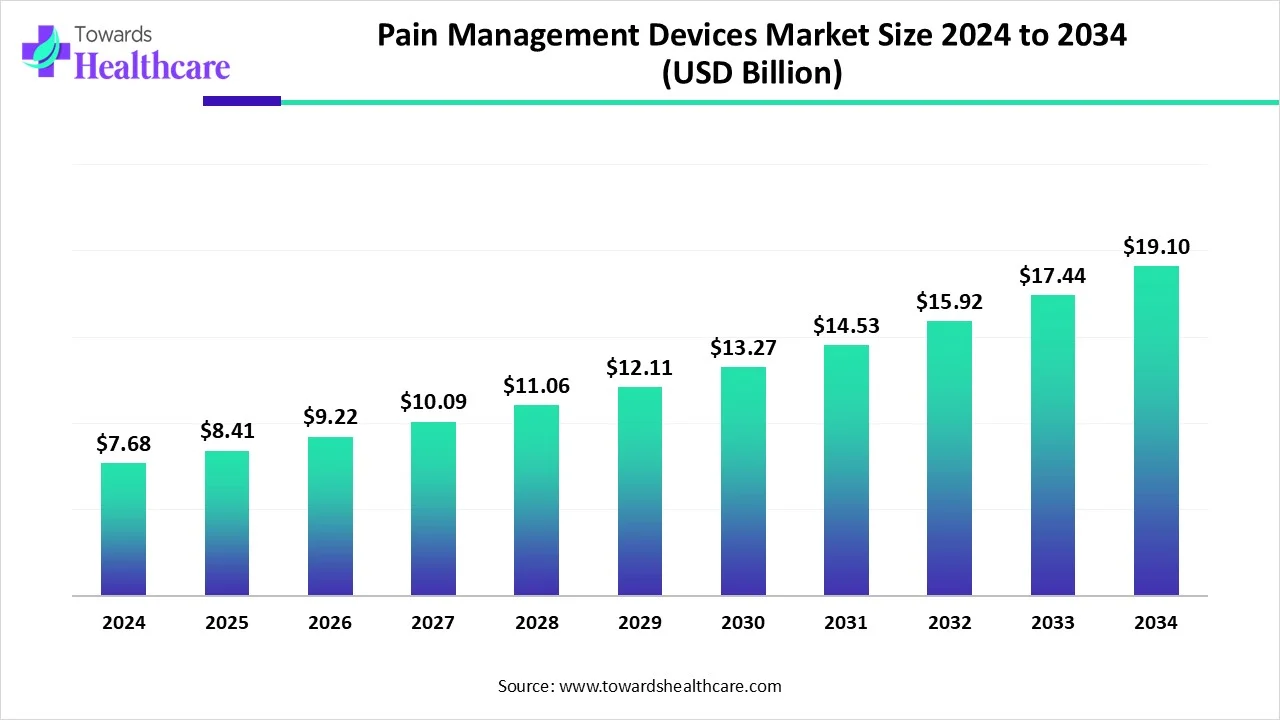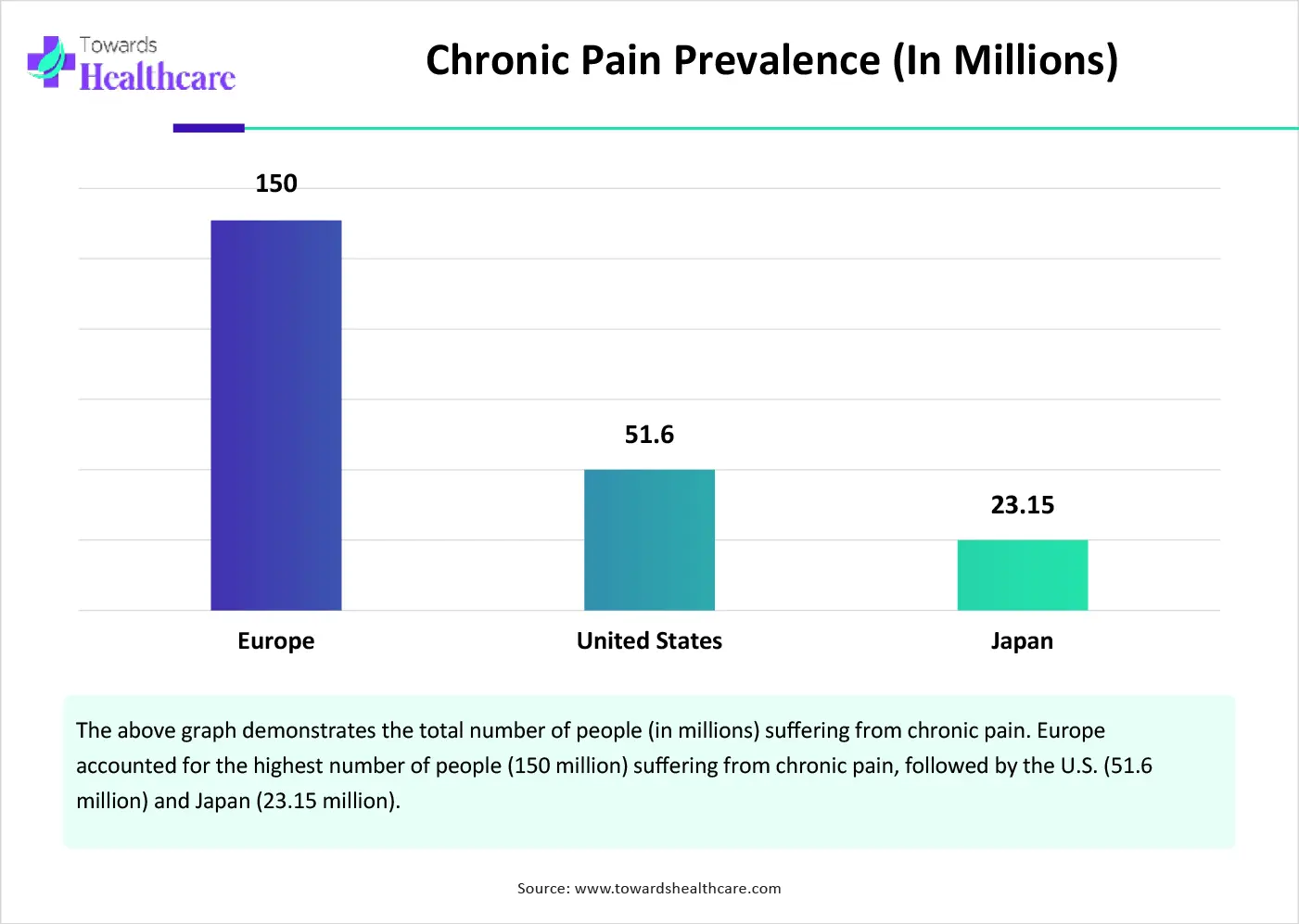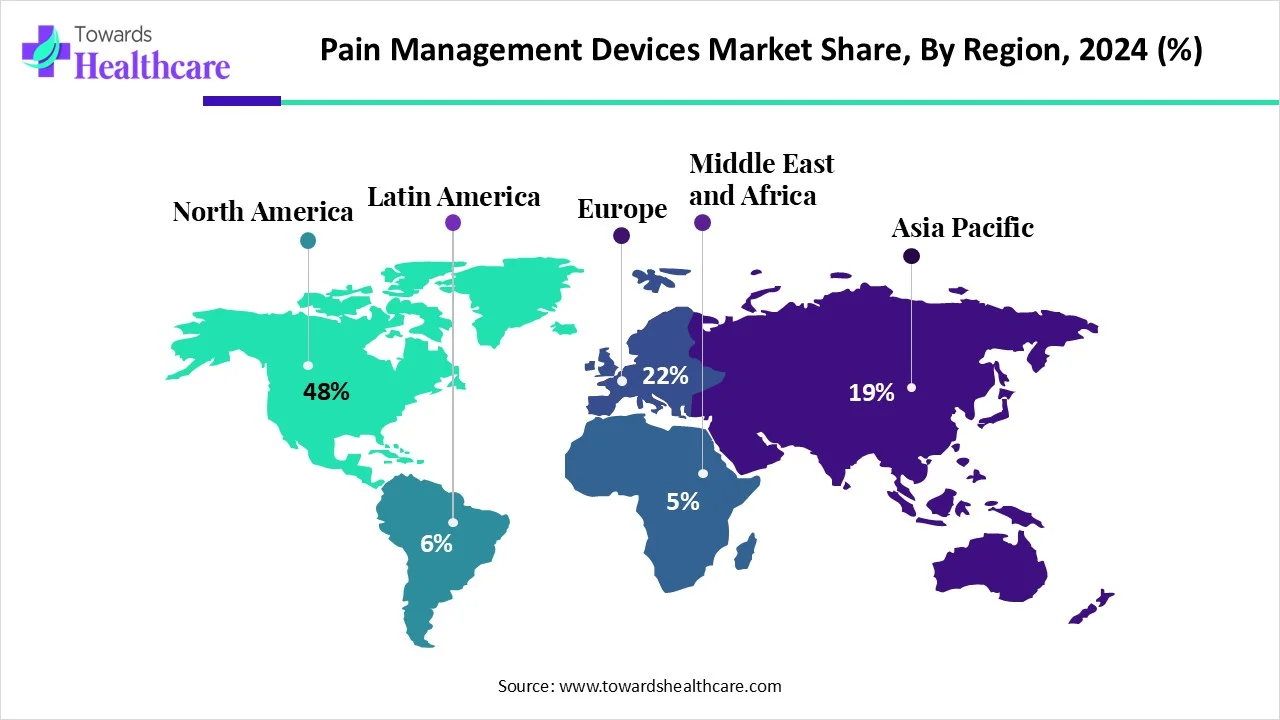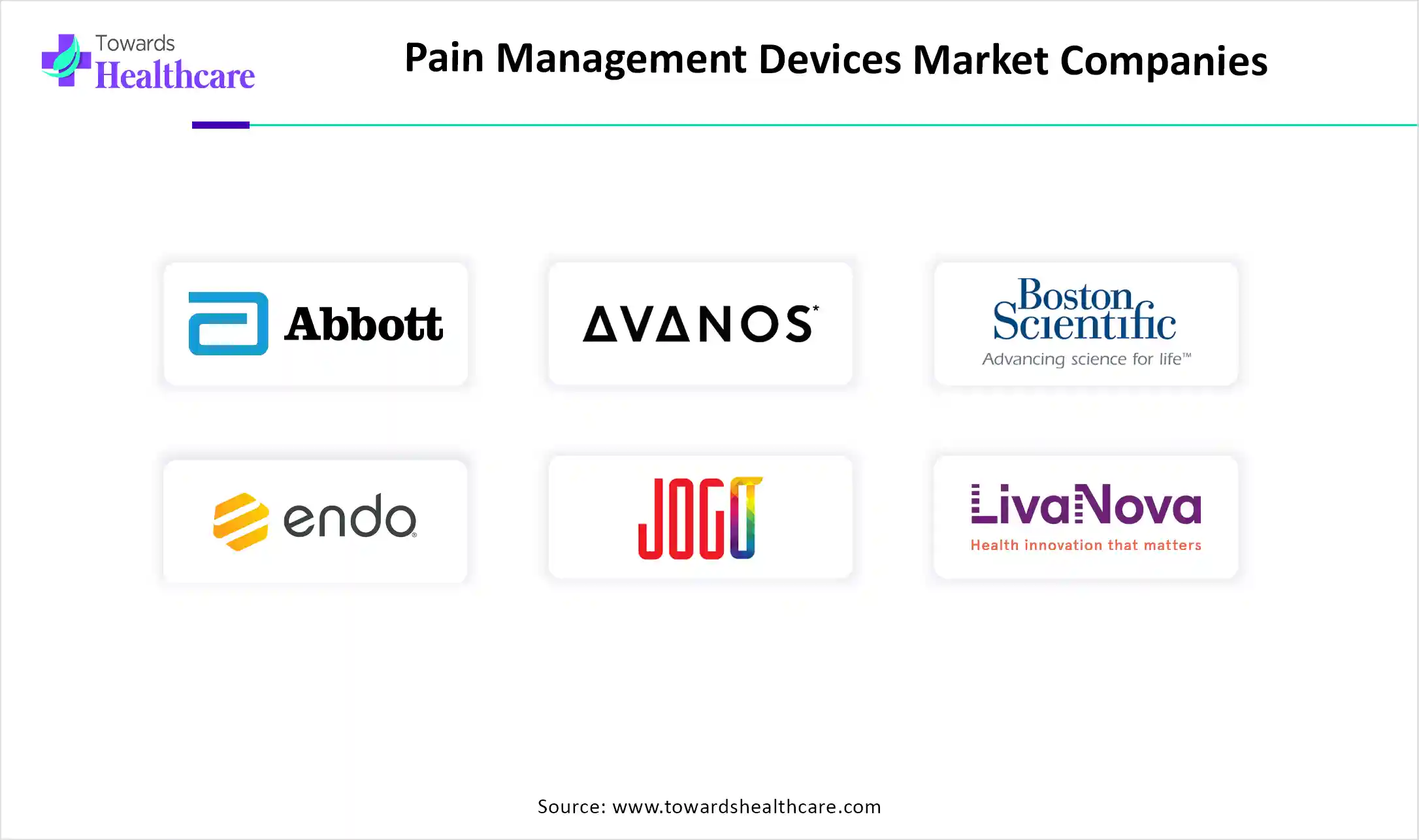December 2025

The global pain management devices market size is calculated at USD 7.68 billion in 2024, grew to USD 8.41 billion in 2025, and is projected to reach around USD 19.1 billion by 2034. The market is expanding at a CAGR of 9.54% between 2025 and 2034.

The pain management devices market is mainly driven by the rising prevalence of chronic and acute pain. The growing demand for personalized treatment and the rapidly expanding medical device sector potentiate market growth. Numerous government organizations encourage patients to seek early diagnosis and intervention for pain disorders. The future of the market looks promising with the development of innovative medical devices and the integration of AI/ML in pain management devices. People are becoming increasingly aware of minimally invasive, or non-invasive procedures, thereby directing future growth.
| Metric | Details |
| Market Size in 2025 | USD 8.41 Billion |
| Projected Market Size in 2034 | USD 19.1 Billion |
| CAGR (2025 - 2034) | 9.54% |
| Leading Region | North America share 48% |
| Market Segmentation | By Product, By Application, By End-Use, By Region |
| Top Key Players | Abbott Laboratories, Avanos Medical, Boston Scientific Corporation, Endo International plc, JOGO Health, LivaNova, NeuroOne Medical Technologies Corporation, Nevro Corp, Novartis AG, SPR Therapeutics, Inc., Stryker Corporation, Zynex, Inc |
Pain management helps to prevent, reduce, or relieve chronic and acute pain through various interventions. Some common interventions include medications, procedures, exercises, and therapy. Pain management devices are based on invasive and non-invasive approaches that serve as adjuvants to existing regimens. The different types of devices include transcutaneous electrical nerve stimulation (TENS), peripheral nerve stimulation, spinal cord nerve stimulation, radiofrequency ablation, and a patient-controlled analgesia pump.
Numerous factors influence market growth, including the rising prevalence of pain conditions and the need for personalized care. Technological advancements and growing research and development activities lead to the development of novel and innovative medical devices for pain management. The rapidly expanding medical device sector and increasing investments and collaborations augment the market. The increasing number of surgeries and the demand for minimally invasive surgeries potentiate market growth.
Artificial intelligence (AI) can revolutionize the way pain management devices work and provide personalized care. Integrating AI in neuromodulation devices can enhance data collection and monitoring phases, improving treatment outcomes for patients with chronic pain. AI-enabled sensors are embedded in wearable devices to enable continuous tracking of vital signs, activity levels, and pain fluctuations. These devices provide real-time feedback to healthcare professionals, enabling them to make proactive decisions. The integration of the Internet of Things (IoT) technology also has immense potential in enhancing the efficiency of pain management devices.
Rising Prevalence of Pain
The major growth factor of the pain management devices market is the rising prevalence of acute and chronic pain conditions. Pain can be caused by a variety of conditions, including arthritis, autoimmune conditions, cancer, neuropathic pain, and spinal cord injuries. The growing geriatric population, obesity, and long-term chronic disorders, such as hypertension and diabetes, are the major risk factors of chronic pain. According to a recent report published in the Lancet Rheumatology journal, more than 840 million people globally are estimated to suffer from back pain by 2050. This is attributed to the increasing population and the aging population.

High Cost
The cost of several advanced pain management devices is generally expensive. The entire procedure, including surgery and rehabilitation, for managing pain in a healthcare organization can also be costly. This limits the affordability of many people from low- and middle-income countries, reducing accessibility to advanced care.
What is the Future of the Pain Management Devices Market?
The future of the market is promising, driven by the growing demand for minimally invasive or non-invasive procedures and the latest innovations in pain management devices. Minimally invasive procedures aid in the faster recovery of patients and shorter hospital stays. These advantages are achieved through smaller incisions and reduced tissue trauma. Non-invasive procedures can treat a wide range of chronic conditions without any incisions in the human body. This saves a lot of time and cost for both healthcare professionals and patients. Moreover, the latest innovations in pain management devices include advancements in neuromodulation techniques and digital health tools.
By product, the neurostimulation segment held a dominant presence in the market in 2024. This segment dominated due to the availability of invasive and non-invasive devices and advancements in neuromodulation techniques. Neurostimulation devices can be implanted or external devices that use electrical stimulation to change pain signals and pain perception in the body. They are widely used for conditions that are non-curable through conventional techniques. Neurostimulation eliminates the risk of adverse effects or addiction caused by painkillers. Additionally, the procedure to implant neurostimulation devices involves a minimally invasive procedure, improving treatment outcomes and increasing accessibility.
By product, the radiofrequency ablation segment is expected to grow at the fastest rate in the market during the forecast period. Radiofrequency ablation (RFA) refers to the use of radio waves to heat and destroy tissues, providing relief from long-lasting pain. The increasing affordability and easy-to-use technique promote the segment’s growth. RFA eliminates the need for surgery and reduces the use of pain medications. Technological advancements in radiofrequency techniques and the growing demand for personalized treatment potentiate the demand for RFA.
By application, the neuropathic pain segment led the global market in 2024. The segmental growth is attributed to the rising prevalence of neuropathic pain and the need for advanced devices to treat long-term pain. Neuropathic pain is estimated to affect approximately 7-10% of the total adult population. This pain is mainly caused by a chronic, progressive nerve disease due to injury or infection. Pain management devices for neuropathic pain provide targeted relief.
By application, the cancer segment is expected to grow with the highest CAGR in the market during the studied years. The increasing complexity of cancer pain and the rising cancer cases boost the segment’s growth. Cancer pain can be caused by tumors, bone pain, cancer surgery, peripheral neuropathy, and side effects of chemotherapy and radiation. The most common pain management devices for treating cancer pain are infusion pumps and nerve stimulators. The World Health Organization (WHO) estimated that over 35 million new cancer cases would be reported in 2050. (Source: WHO)
By end-use, the hospitals & clinics segment held the largest revenue share of the market in 2024. The presence of a favorable infrastructure and suitable capital investment enables healthcare organizations to adopt cutting-edge technologies. Hospitals and clinics provide multidisciplinary expertise to patients. They are also part of clinical trials assessing the safety and efficacy of novel pain management devices. This enables patients to access advanced devices before market approval. Favorable reimbursement policies also encourage numerous patients to prefer hospitals and clinics.
By end-use, the physiotherapy centers segment is expected to expand rapidly in the market in the coming years. The rising demand for physical therapies to treat chronic pain propels the segment’s growth. The presence of skilled professionals and specialized equipment also potentiates the demand for physiotherapy centers. Innovative devices, such as wearable devices and smart pain management devices, play a vital role in managing patients’ conditions.

North America dominated the global market share by 48% in 2024. The presence of a robust healthcare infrastructure and favorable government support are the major growth factors of the market in North America. Government organizations provide funding and launch initiatives to increase awareness of the effective treatment of acute and chronic pain. The increasing number of clinical trials and state-of-the-art research and development facilities promote market growth.
Out of the total 543 clinical trials related to pain management devices, around 172 clinical trials are registered in the U.S. as of June 2025. (Source: Clinical Trials) The Healthy People 2030 initiative by the Office of Disease Prevention and Health Promotion aims to help people with high-impact chronic pain manage their pain and reduce its impact. (Source: OASH Health)
About 1 in 5 Canadians lives with chronic pain. The Government of Canada formed the Canadian Pain Task Force to provide evidence and best practices advice for preventing and managing chronic pain. A national action network, “Pain Canada”, was formed, which comprises 8 million Canadians.
Asia-Pacific is expected to host the fastest-growing pain management devices market in the coming years. The rising prevalence of low back pain and arthritis, and increasing healthcare expenditure, potentiate the demand for pain management devices. The growing number of medtech startups and increasing investments and collaborations foster the market. Many people prefer rehabilitation services and home healthcare for personalized care. Favorable regulatory frameworks and technological advancements govern the market.
According to a cross-sectional study on 1566 participants, a total of 80.1% of participants reported experiencing pain, with more than 50% suffering from chronic pain. (Source: MDPI) The National Medical Products Administration (NMPA) regulates the approval of pain management devices in China. In 2024, the NMPA approved 65 innovative medical devices. (Source: Cisema)
It is estimated that one-sixth of the Indian population suffers from musculoskeletal pain, and several million from various forms of arthritis, such as 4.22 million from rheumatoid arthritis, 54.44 million from osteoarthritis, and 17.24 million from soft tissue rheumatism. (Source: Indian Express) In February 2025, India’s first multidisciplinary chronic pain management clinic network, Nivaan Care, raised $4.25 million in seed funding. (Source: eHealth)
Europe is expected to grow at a considerable CAGR in the pain management devices market in the upcoming period. The rapidly expanding medical device sector and increasing investments contribute to market growth. The increasing adoption of advanced technologies and the growing number of surgeries boost the market. Favorable government support promotes the use of pain management devices. The growing research and development activities, as well as the presence of key players, drive the market.
Key players, such as David Health Solutions, MKS Health Technologies, and Akkodis, are the major contributors to the market in Germany. Approximately 1% of all adults in Germany have rheumatoid arthritis. The German government supports various initiatives related to arthritis for specialized care and rehabilitation.
Polar Medical and GBUK Group are the major suppliers of pain management devices in the UK. It is estimated that approximately 8 million people suffer from moderate-to-severe chronic pain in the UK. (Source: British Pain Society) Out of this, the prevalence of chronic pain is higher in older age groups, with 62% of cases in people with 75 years and above.
Latin America is expected to grow at a notable CAGR in the pain management devices market in the foreseeable future. The market is driven by the rising prevalence of acute and chronic pain disorders and the burgeoning medical device sector. Numerous international companies set up their manufacturing facility in Latin America to deliver advanced pain management devices to the local population. The development of pain management devices is supported by the Latin American government.
The latest study conducted on 1,755 people demonstrated that the prevalence rate of chronic pain in Mexico is from 29% to 41%. Researchers also found that 19% of adults in urban areas of the Mexican Republic may have chronic pain. Additionally, a nationwide retrospective analysis found that a total of 16,061 laparoscopic procedures were performed out of 97,234 surgical procedures.
Approximately 35.7% of the total adult population and 47.32% of the geriatric population suffer from chronic pain in Brazil. ANVISA regulates the approval and use of pain management devices in Brazil. It ensures the protection of the population’s health by executing control of the production, marketing, and use of medical devices.

Aman Rishi, Vice President and General Manager of Stryker, India, commented on the launch of the MultiGen 2 Radiofrequency Generator, stating that MultiGen 2 is the next generation of radiofrequency ablation that provides physicians with control and customization to perform chronic pain management procedures with confidence. The device has higher efficiency and reliability, providing relief to millions of people living with facet joint pain. (Source: Economic Times)
Researchers develop novel pain management devices based on patients’ conditions and incorporate advanced sensors, wearable technology, and virtual reality.
Key Players: Medtronic, Abbott, and Stryker Corporation
Pain management devices are assessed for their safety and efficacy in humans, as well as their compatibility with humans. Regulatory agencies like the FDA, EMA, and NMPA approve these devices based on clinical trial data.
Patient support & services refer to training individuals about the use of such devices and providing reimbursement.
By Product
By Application
By End-Use
By Region
Projections indicate that, molecular diagnostics industry is projected to rise from USD 16.24 billion in 2024 ...
December 2025
December 2025
December 2025
December 2025